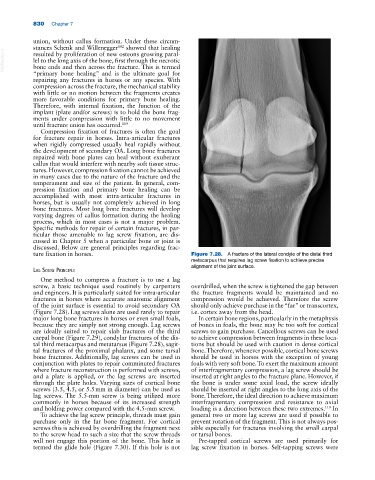Page 864 - Adams and Stashak's Lameness in Horses, 7th Edition
P. 864
830 Chapter 7
union, without callus formation. Under these circum
102
stances Schenk and Willenegger showed that healing
VetBooks.ir lel to the long axis of the bone, first through the necrotic
resulted by proliferation of new osteons growing paral
bone ends and then across the fracture. This is termed
“primary bone healing” and is the ultimate goal for
repairing any fractures in horses or any species. With
compression across the fracture, the mechanical stability
with little or no motion between the fragments creates
more favorable conditions for primary bone healing.
Therefore, with internal fixation, the function of the
implant (plate and/or screws) is to hold the bone frag
ments under compression with little to no movement
until fracture union has occurred. 119
Compression fixation of fractures is often the goal
for fracture repair in horses. Intra‐articular fractures
when rigidly compressed usually heal rapidly without
the development of secondary OA. Long bone fractures
repaired with bone plates can heal without exuberant
callus that would interfere with nearby soft tissue struc
tures. However, compression fixation cannot be achieved
in many cases due to the nature of the fracture and the
temperament and size of the patient. In general, com
pression fixation and primary bone healing can be
accomplished with most intra‐articular fractures in
horses, but is usually not completely achieved in long
bone fractures. Most long bone fractures will develop
varying degrees of callus formation during the healing
process, which in most cases is not a major problem.
Specific methods for repair of certain fractures, in par
ticular those amenable to lag screw fixation, are dis
cussed in Chapter 5 when a particular bone or joint is
discussed. Below are general principles regarding frac
ture fixation in horses. Figure 7.28. A fracture of the lateral condyle of the distal third
metacarpus that requires lag screw fixation to achieve precise
alignment of the joint surface.
lag sCrew PrInCIPle
One method to compress a fracture is to use a lag
screw, a basic technique used routinely by carpenters overdrilled, when the screw is tightened the gap between
and engineers. It is particularly suited for intra‐articular the fracture fragments would be maintained and no
fractures in horses where accurate anatomic alignment compression would be achieved. Therefore the screw
of the joint surface is essential to avoid secondary OA should only achieve purchase in the “far” or transcortex,
(Figure 7.28). Lag screws alone are used rarely to repair i.e. cortex away from the head.
major long bone fractures in horses or even small foals, In certain bone regions, particularly in the metaphysis
because they are simply not strong enough. Lag screws of bones in foals, the bone may be too soft for cortical
are ideally suited to repair slab fractures of the third screws to gain purchase. Cancellous screws can be used
carpal bone (Figure 7.29), condylar fractures of the dis to achieve compression between fragments in these loca
tal third metacarpus and metatarsus (Figure 7.28), sagit tions but should be used with caution in dense cortical
tal fractures of the proximal phalanx, and some tarsal bone. Therefore, whenever possible, cortical bone screws
bone fractures. Additionally, lag screws can be used in should be used in horses with the exception of young
conjunction with plates to repair comminuted fractures foals with very soft bone. To exert the maximum amount
where fracture reconstruction is performed with screws, of interfragmentary compression, a lag screw should be
and a plate is applied, or the lag screws are inserted inserted at right angles to the fracture plane. However, if
through the plate holes. Varying sizes of cortical bone the bone is under some axial load, the screw ideally
screws (3.5, 4.5, or 5.5 mm in diameter) can be used as should be inserted at right angles to the long axis of the
lag screws. The 5.5‐mm screw is being utilized more bone. Therefore, the ideal direction to achieve maximum
commonly in horses because of its increased strength interfragmentary compression and resistance to axial
119
and holding power compared with the 4.5‐mm screw. loading is a direction between these two extremes. In
To achieve the lag screw principle, threads must gain general two or more lag screws are used if possible to
purchase only in the far bone fragment. For cortical prevent rotation of the fragment. This is not always pos
screws this is achieved by overdrilling the fragment next sible especially for fractures involving the small carpal
to the screw head to such a size that the screw threads or tarsal bones.
will not engage this portion of the bone. This hole is Pre‐tapped cortical screws are used primarily for
termed the glide hole (Figure 7.30). If this hole is not lag screw fixation in horses. Self‐tapping screws were

